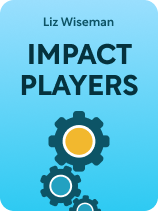

This article is an excerpt from the Shortform book guide to "Impact Players" by Liz Wiseman. Shortform has the world's best summaries and analyses of books you should be reading.
Like this article? Sign up for a free trial here.
Would you like to be the employee everyone counts on? How can you handle unexpected challenges without passing them off to someone else?
Knowing how to improve follow-through at work is a crucial skill that sets exceptional employees apart. In Impact Players, Liz Wiseman reveals the key characteristics and strategies that help impact players consistently deliver results, even when faced with obstacles.
Read on to discover practical ways to become the reliable team member your organization needs.
How to Improve Follow-Through
Wiseman argues that a key habit of impact players is that they take ownership of their work and see it to completion, regardless of challenges that come up along the way. Managers can rely on these workers to deliver consistent, quality results without needing constant reminders or supervision. In her book, Wiseman discusses how impact workers set themselves apart in this way, and she shares her advice on how to improve follow-through at work.
Wiseman explains that, when challenges arise, most workers tend to avoid or deflect them. They alert others about the issue so that someone else can handle it. Impact players, on the other hand, stick with the task and tackle the problems themselves. Wiseman identifies two characteristics that help impact players to face these unexpected challenges head-on: resilience (the ability to recover from setbacks) and grit (the determination to do the work necessary to reach a goal).
(Shortform note: Even if you have resilience and grit, you may still find it hard to finish tasks if you’re too perfectionistic. In Linchpin, Seth Godin says that perfectionism can prevent you from completing a project because you may be reluctant to finalize something that might have errors. He further argues that perfect work is actually a bad thing—it means you weren’t being innovative enough. To combat perfectionism and see projects to completion, Godin recommends you set deadlines for every project and release it into the world when the deadline arrives, even if it still has flaws.)
To prepare yourself to handle unexpected challenges, Wiseman suggests several strategies.
1) Recruit a lookout. Ask a coworker to keep an eye on any weaknesses or potential threats you may face as you work. Getting a different perspective can help you anticipate potential challenges on the horizon. At the same time, be willing to do the same for them. By preparing for possible problems, you can focus all your effort on finding prompt, innovative solutions.
(Shortform note: Teaming up with others to identify potential challenges is a common tactic used by people who are good at predicting the future. In Superforecasting, Dan Gardner explains that groups tend to make more accurate judgments than individuals. Thus, it may be helpful to not only share information with one coworker but to consult many sources and use various tools to get a better picture of the future and potential challenges.)
2) Ask for what you need. Anticipate possible obstacles early and clearly communicate to your boss and your team what you’ll need for success from the very beginning. This way, you secure the resources and support to overcome challenges before they arise.
(Shortform note: In The Success Principles, Canfield recommends you specify three things when making requests from others: behavior, time, and money. Describe exactly what you need someone to do, the time you’d like it to be done by, and, if you’re requesting money, the specific amount you need. Making specific requests prevents misunderstandings and ensures you get the support you need.)
3) Know when to let go. Regularly assess the pros and cons of continuing with a task, recognize when a project is draining more resources and energy than it’s worth, and have the courage to let it go.
(Shortform note: It can be hard to let go of projects because of the sunk cost fallacy—the tendency to want to continue working on a project because you’ve already invested considerable time, resources, and energy into it. In The Voltage Effect, John A. List agrees you should let go of failing projects, recommending you do so as soon as possible to minimize losses. To decide whether to let go of a project, consider other ways you could spend the resources you’ve allocated for that project. If it seems like those resources would be more useful for other ideas or projects, it’s probably best to move on.)

———End of Preview———
Like what you just read? Read the rest of the world's best book summary and analysis of Liz Wiseman's "Impact Players" at Shortform.
Here's what you'll find in our full Impact Players summary:
- How to become a star player at your workplace
- The three qualities of an impact player mindset
- Advice for creating an entire team of impactful employees






